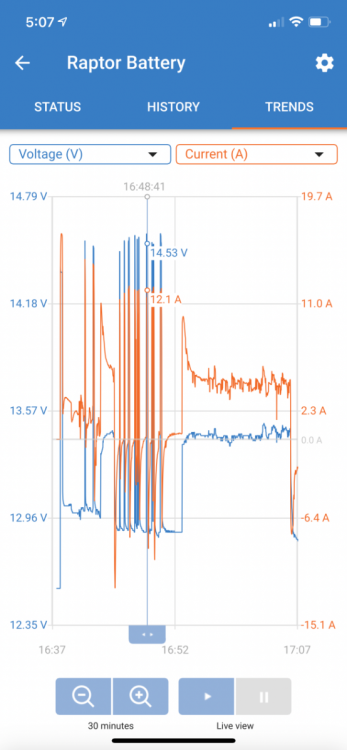-
Posts
3,835 -
Joined
-
Last visited
-
Days Won
212
Everything posted by Overland
-
When my first water heater broke, I was told by Truma that they had no user serviceable parts and my only option was to go back to Oliver or a service center. Yet, they include schematics and a parts diagram in their manual, and you seem to be able to buy parts in other countries. Furthermore, this year they had no hesitation in sending me a new control board to install myself. So, mixed signals. As for any kind of limp home mode, my experience is that it either works or not. The pump itself isn't technically required for the unit to work, so you'd think that the ECU could just disable the pump related features, but that doesn't seem to be the case.
-

MaxxFan service lubrication repair help?
Overland replied to John E Davies's topic in Mechanical & Technical Tips
I think I’ll get a bottle that myself. Thanks! -
Mine used to throw various voltage errors all the time but they’d always clear by just turning the unit off and on again (using the switch at the unit, not the remote). A circuit board replacement fixed the problem. My only guess is that you’ve got a bad pump, which probably does mean taking it in for service. Service availability seems to be a real problem with the Trumas. Where are you located? I believe that they run a mobile repair service in the southwest - maybe elsewhere too?
-
Exactly. Here’s a chart from a 30 minute trip I just made. This is from the battery monitor on an AGM house battery that I have under the back seat of my truck. It’s connected to the starter battery with 2 awg cables and a Victron Cyrix smart relay. I have a 12 volt fridge attached to the house battery, which is the amperage load that you see on the chart. I had auto start/stop disengaged. In this case, I had just made another short highway trip that had already fully charged my start battery, so you don’t see a prolonged period at 14.6+ volts are the start. The house battery was at about 85%. You can see that the voltage goes into the 14’s for just a brief period before settling in at 12.8 or so. The spikes at the beginning of the drive are in stop-go traffic. (The truck has electric assist on the brakes so those are the spikes.) You’ll see that it evens out for a bit once I get in the highway, but then jumps suddenly to around 13.4 volts. That’s when I turned on my headlights. (BTW, that’s been a GM owners trick for a while to get their voltage up to a charging level.) So you can see that modern electrical systems only provide the voltage that the truck needs at any given time. They do this regardless of what other load you add to the system. Unfortunately, while I may be able to trick the system into providing 13.4 volts, that isn’t enough to charge lithiums, since I’d probably only see 13.2 or less at the battery. So yes, a B2B charger is absolutely needed.
-
That's why almost every post I make has an edited tag. ☺️ Like this ⬇️
-
I don't know what the liability issue would be. The problem with tow vehicles charging lithiums exists with lead acid also, just most people don't realize it. The issue with power from the trailer flowing back to the tow vehicle seems to only exist with certain tow vehicles and isn't exclusive to lithiums. Nothing is going to get hurt either way from the small amount of power that's flowing - Oliver should just tell people not to expect much charge from their tow vehicle due to the wiring and leave it at that. If people want to modify their vehicles and trailers for a better charge, then that's up to them to do the research and do it right. A liability issue might be pointing owners to a specific solution, if it turns out that solution was incorrect.
-
I'd also highly recommend the Ford backup assist. It's just an easier way to do it in all situations.
-

Current draw with Smart Shunt using battery cutoff
Overland replied to carnivore's topic in Ollie Modifications
I'd recommend two separate disconnects, one for the solar and one for the batteries. Only because it's an idiot proof solution, and I'm often an idiot. -

Current draw with Smart Shunt using battery cutoff
Overland replied to carnivore's topic in Ollie Modifications
One thought is that there may be times when you want to disconnect either the batteries or the solar, but not both. For example, when I was recently trying to diagnose my bad batteries, I had to disconnect the solar in order to get an accurate voltage reading. Or you may want to cut the solar in freezing temps to prevent charging LFP batteries, but don't want to completely cut power to the trailer. -

MaxxFan service lubrication repair help?
Overland replied to John E Davies's topic in Mechanical & Technical Tips
Yes, I've already replaced the circuit board once and I'm sure that I'll need another at some point. It seems to be moisture related. The first time, it went out after a slight rain with the fan open. This time it happened right after a dusting of snow, again with the fan open. I keep meaning to get a spare control board. I was just glad that this time it was stuck on rather than off. If it's stuck on, I can at least control it with the circuit breaker. -
Oliver should consider the option of providing the mounts and letting the owner install whatever awning they want on their own.
-
Not that specifically but something similar. Thanks for the link. For the moment, it’s just an idea - but there is a video out there of someone who’s converted his Sonos Play to low voltage, so I’m hopeful that the same can be done with a Sonos Beam. I just need to open it up sometime to see what sort of power is required. Hopefully 24 volt like the Play.
-
One gas station trick, when the lanes face the building, is to drive around and pull through facing out. That way you can get a sense if the trailer can make the turn before you’ve committed yourself, and you’ll be less likely to get pinned in later by other traffic. Just be sure when you pick a pump that you can pull through to the farthest one so that you don’t leave your trailer in the traffic lane.
-

MaxxFan service lubrication repair help?
Overland replied to John E Davies's topic in Mechanical & Technical Tips
I agree. I think now that I seem to have gotten my Truma sorted out, I’m going to bestow the title of Most Troublesome Component to the MaxxFan. Ours recently decided that it wanted to stay open. I’d close it, and a few minutes later it would open again. I’d close it again and it would open again. Finally I just flipped the breaker. A few days later it started working and has been fine since. -
I can only echo what’s been said. For some reason on our recent trip, other people were determined to trap us in gas stations, but the Ollie triumphed. It’s remarkably nimble, within reason. I’m sure that I’ll get in trouble someday, since my initial reaction to any size limit sign is “...except for Ollies.”
-
Our awning light strip has I think three brightness levels, and also a warm white option in addition to the cool white and colors. But I’m considering swapping it out for a Philips Hue light strip. We have Hues in our house and have really come to like them. It would add complexity since I’d have to add a bridge, but we already have a router and I could easily add a 24 volt circuit to power the strip. The bridge is 5 volt so I could find a USB cable for it no problem. The advantage would be infinite brightness and color levels plus it would set me up for some additional Hue strips later. I think with a 24 volt circuit that I could also power my Sonos directly rather than with the inverter.
-
If the setting were linked to the heat strip, then I’d understand, but it isn’t. I’m trying to imagine why anyone would want the AC fan running while the furnace is on. Someone who likes to pretend that they’re camped next to an airport?
-
Same here. Adding a light strip to the awning is a good option if you have an earlier Ollie or didn’t get that from the factory. We’ve found that the main lights will attract bugs right to your door but the awning lights keep them far enough away that they rarely get inside. They also put light more where we need it rather than right against the trailer. I’ve been looking at some of the different gel options that are available for photographers and theater lighting. You have many more choices to create a nice warm white rather than amber, but the problem is that none of them are adhesive, so you’d have to find a good way to attach them.
-
I’m sure that’s it. It’s an easy setting to change inadvertently. And it’s also very unintuitive.
-
You can do that - that's how the house battery in my truck is wired - but I wouldn't depend on it unless you've verified that your alternator will produce a continuous charge. Mine doesn't - after a few minutes recharging the start battery, the voltage drops. We had a discussion on here a few months back with the LifeBlue owner about it - short version is that he and I disagree. That may be changing with hybrid trucks, since the hybrid battery bank is constantly being charged and discharged. That's why I'm really interested in details about the Ram e-torque, and of course the new F150 as well.





